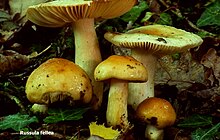Russula fellea
| Russula fellea | |
|---|---|

| |
| Scientific classification | |
| Domain: | Eukaryota |
| Kingdom: | Fungi |
| Division: | Basidiomycota |
| Class: | Agaricomycetes |
| Order: | Russulales |
| Family: | Russulaceae |
| Genus: | Russula |
| Species: | R. fellea
|
| Binomial name | |
| Russula fellea (Fr.) Fr.
| |
| Russula fellea | |
|---|---|
| Gills on hymenium | |
| Cap is convex or flat | |
| Hymenium is adnexed | |
| Stipe is bare | |
| Spore print is white | |
| Edibility is inedible | |
The mushroom Russula fellea goes by the common name of the geranium-scented russula, or bitter russula and is a member of the genus Russula, all of which are commonly known as brittlegills. It is straw or honey coloured and in Britain grows in beech woods during autumn. It is inedible.
Taxonomy
It was first described and named in 1821 by the Swedish mycologist
Description
The cap is usually 4–9 cm wide, and convex, flattening later, and often with a broad central boss (umbo). It is sometimes furrowed at the margin when mature. The similarly coloured, but paler stipe is firm and stout, and is 2–6 cm high by 1–2 cm wide. The gills are adnexed, and are the same colour as the stem, giving a spore print that is white to pale cream. The flesh is white, and does not change colour on cutting. It tastes hot,[1] and often has a bitter tang. The smell is variously reported to resemble geraniums,[1] or apple sauce.[2]
Distribution and habitat
Russula fellea appears in autumn, and is found with beech (
Edibility
This mushroom is inedible, having a very hot bitter taste.[1]
See also
References
- ^ ISBN 0-330-44237-6.
- ISBN 3-8331-1239-5.
- ISBN 0-7513-1070-0.
 Media related to Russula fellea at Wikimedia Commons
Media related to Russula fellea at Wikimedia Commons
